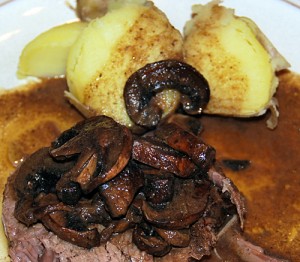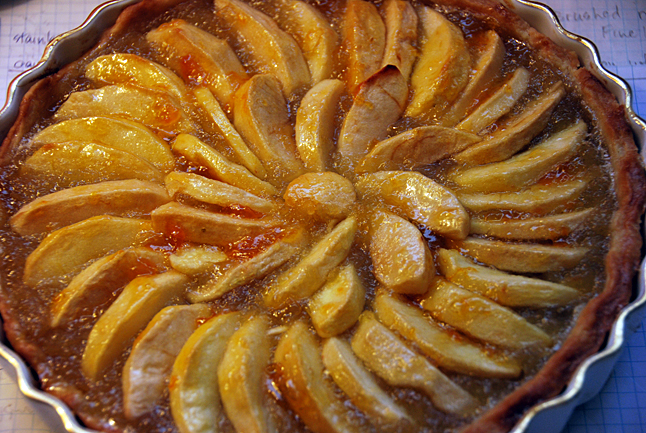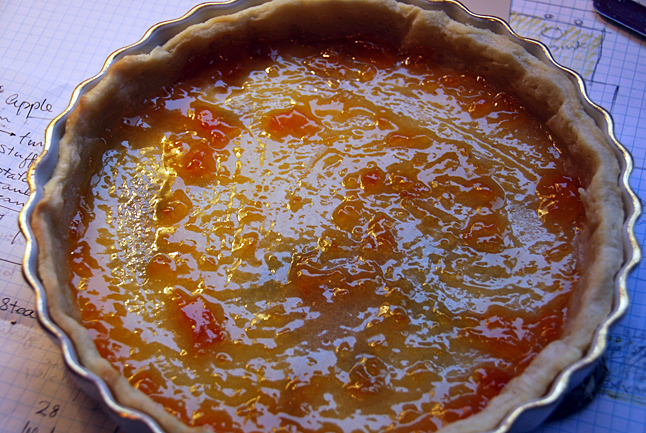
Slow cooking has become popular again—think of pulled pork — perhaps as the carnivores of the gastronomic world search for the big earthy flavours of old fashioned stewpots that leave the kitchen steamy with soul satisfying aromas. Here is an easy pot roast—to simmer in a slow cooker or in a slow oven, about 300° F, for 4-5 hours while you get on with other chores, or even hit the slopes for the day.
I added mushrooms, but you don’t have to. If you do, be sure to sauté them separately in a little butter and oil before adding them to the pot, no more than an hour before the whole thing is done, and possibly just before serving.
3-4 lb rolled rump roast or similar, fat removed
2 tbsp oil
2 large onions, sliced thin
1-2 cups red wine
1 cup beef broth or water
2 tbsp chopped parsley
1 tbsp fresh thyme, leaves only
salt and pepper
Rub salt and freshly ground pepper all over the meat.

Heat the oil in a large frying pan and brown the meat on all sides.
Put the meat in a slow cooker set to AUTO. Add the parsley and thyme.
Now brown the onions in the same frying pan — this will take about ten minutes. They should be soft but not crisp. Add the onions to the pot.
Add enough red wine to cover the meat and onions. If 2 cups doesn’t do the job, add some broth or water.
Cover, and set the cooker to AUTO or the oven to 300° F.
You can peek every hour or so and turn the meat over if it seems to stick up above the level of the liquid.
After 4-5 hours, the meat will be cooked and the onions almost disintegrating. Help them along: spoon them into a sieve over a large bowl, and smash them through the sieve. Return the onion puree to the pot and stir into the gravy.
Add sautéd mushrooms before serving.
To serve, remove the roast from the pot and slice it into one inch thick pieces. Leave string for diners to remove — otherwise the whole thing falls apart.
Serve with fresh boiled potatoes — yellow if possible, and red-skinned ones with that creamy texture when they are smashed, sprinkled with some parsley. A salad is nice with this if you’re really hungry, but this is one meal that can actually do without greens.
While you bask in the relaxing smells wafting about, you may want to try the following apple tart. It’s adapted from Julia Child’s Mastering the Art of French Cooking, and is a nice way to use up apples from the fall. Adding the apricot jam pushes the taste volume, and also prevents the crust from getting soggy. The crust is baked blind — the term used for pre-cooking the pastry so as to keep it firm despite the moisture of the apples.

Apple Tart
A tart is a one-crust pie. It gives you the opportunity to be decorative with the filling—the only real work in this tart is choosing and arranging the top layer of apples so that they look well on display.
Pastry
You need a 10-11 inch pie plate—larger than the foil ones. I use an ovenproof quiche dish but you could use a springform pie dish (the bottom comes out) or any sloping-sided ovenproof dish. Round is pretty, but you could do this also in an oval or rectangular pan.
I use my food processor to cut the butter and shortening into the flour. If you don’t have one, you can use two knives, or a pastry blender tool. Cut the butter and fat into tiny bits on top of the flour, mixing all the time, until the whole mixture looks like uncooked oats.
2 cups all purpose flour, sifted before measuring.
2 tbsp white sugar
¼ tsp salt
8 tbsp chilled unsalted butter
3 tbsp Crisco shortening
5-6 tbsp ice cold water
½ cup warmed apricot jam
Blend the flour with the sugar and salt, and cut in the butter and shortening. In a food processor, it is ready when the dough gathers itself into a ball on one side of the machine. In a bowl, it’s ready when you think it looks like oatmeal.
Measure the water into the flour/butter mixture and stir until dough forms. You may have to help it along by scraping the bits up into the ball. Form a flat ball like a huge hockey puck, wrap in waxed paper and refrigerate for an hour while you prepare the filling.
After an hour or so, pre-heat the oven to 375° F. Remove pastry puck from fridge and roll out with a rolling pin or bottle. Flour the surface (I use a piece of parchment paper) liberally, and also flour the rolling pin. Roll from the centre in each of 8 compass directions. Check your tart plate against the rolled dough — the dough should be about 2 inches larger all around than the pie dish. When it is, cut the edge leaving the 2 inches extra.
Using the parchment paper as a help, fold the pastry over itself once, then again, so that you have a quarter of the circle. Lift this carefully into the tart plate and move it gently so that it fits into the centre. Gently press the sides against the sides of the dish, then shape the edge so it is clean and even all the way around. Then, with a fork, prick the pastry all over, so that tiny holes about half an inch apart are all over the dough. This allows air to escape as the pastry bakes, so it doesn’t bubble up.
Blind bake the crust. Cut a round of parchment paper or waxed paper two inches larger than the dish. Fit it into the pie dish on top of the pastry. Into this, on top of the paper, pour pastry marbles, or white dried peas, or elbow macaroni (I keep a jar of macaroni on hand — I’ve used it over and over again for blind baking, but once made the terrible mistake of serving it, or trying to, for lunch.) Fill up the crust so that the sides can’t collapse during baking. Bake for 12 minutes, then remove from the oven. Cool slightly. Remove the paper and the macaroni — all of it — and spread most but not all of the warmed apricot jam over the crust. This, when cooked inside the tart, will prevent the apples from making the crust soggy.
Apple Filling
8 medium to large apples
a lemon
2/3 cup plus 2 tbsp white sugar
3 tbsp butter
¼ cup brandy
When the pastry is in the fridge, you have time to peel and core and slice the apples. Once my spouse did this, to help out, and the next time we were out he bought me an apple corer. It works fairly well, but you must peel the apples first. Be careful when you slice them — by hand or with the corer — as you want enough whole slices to make a decorative top, and the corer tends to break the slices.
Put the slices into a big bowl with the juice of half a lemon and 2 tbsp white sugar. Stir gently, then remove the whole, best looking slices (about 40) and set them aside. Put the other apple slices into large pot, add 2/3 cup sugar and the brandy and the butter. Simmer over medium heat for 30-30 minutes, or until the apples are cooked but still have some shape.
When the apples are cooked there will be a small amount of syrup in the pan with them. Spoon the apples into the tart plate on top of the apricot jam. Make a nice flat bed for the decorative apples slices.
Working in a spiral pattern, arrange the reserved apple slices on top of the cooked apples.
Bake the tart for 30 minutes at 375°. Turn the heat down, remove the tart and paint as a glaze on top of the apples the remaining apricot jam. Use a brush. Return to the oven for 10 minutes, or enough to melt the apricot jam and make the tart top shiny. Remove from oven and cool somewhat, but try to serve warm, with ice cream.




